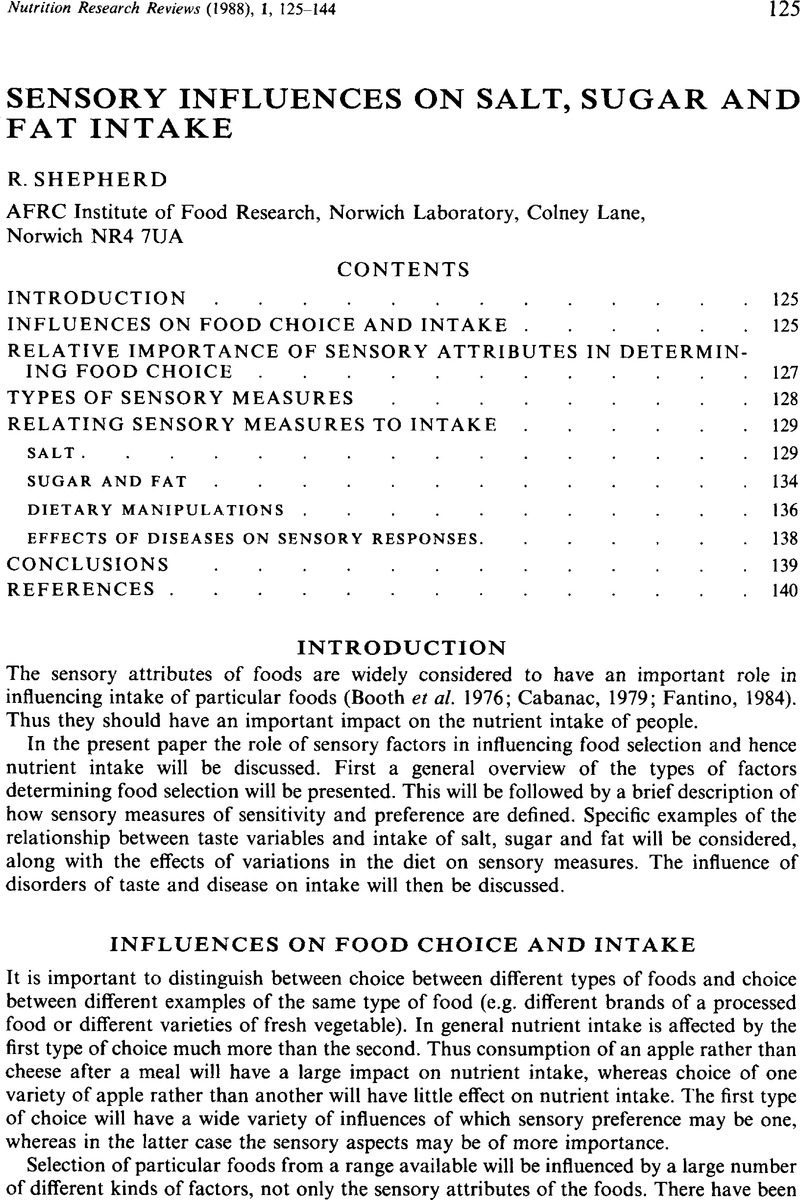Crossref Citations
This article has been cited by the following publications. This list is generated based on data provided by Crossref.
SHEPHERD, R.
WHARF, S. G.
and
FARLEIGH, C. A.
1989.
The effect of a surface coating of table salt of varying grain size on perceived saltiness and liking for paté.
International Journal of Food Science & Technology,
Vol. 24,
Issue. 3,
p.
333.
Tuorila, Hely
Lehtovaara, Armi
and
Matuszewska, Irena
1990.
Sandwiches and milk with varying fat and sodium contents: What is the best combination?.
Food Quality and Preference,
Vol. 2,
Issue. 4,
p.
223.
Farleigh, C.A.
Shepherd, R.
and
Wharf, S.G.
1990.
The effect of manipulation of salt pot hole size on table salt use.
Food Quality and Preference,
Vol. 2,
Issue. 1,
p.
13.
Crovetti, R.
Porrini, M.
Simonetti, P.
and
Testolin, G.
1993.
Food flavourings with natural and nature‐identical products: Acceptability and nutritional significance.
Flavour and Fragrance Journal,
Vol. 8,
Issue. 2,
p.
91.
Love, J.
1994.
Quality Attributes and their Measurement in Meat, Poultry and Fish Products.
p.
337.
Ship, Jonathan A.
Duffy, Valerie
Jones, Judith A.
and
Langmore, Susan
1996.
Geriatric Oral Health and Its Impact on Eating.
Journal of the American Geriatrics Society,
Vol. 44,
Issue. 4,
p.
456.
Rozin, Paul
2000.
The Cambridge World History of Food.
p.
1476.
2000.
The Cambridge World History of Food.
p.
1379.
Zandstra, E.H.
De Graaf, C.
Mela, D.J.
and
Van Staveren, W.A.
2000.
Short- and long-term effects of changes in pleasantness on food intake.
Appetite,
Vol. 34,
Issue. 3,
p.
253.
Younger, K. M.
2007.
Editorial.
Nutrition Research Reviews,
Vol. 20,
Issue. 2,
p.
119.
de Graaf, C.
2007.
Understanding Consumers of Food Products.
p.
30.
Chan, Mei‐Yen
Zhao, Yulan
and
Heng, Chew‐Kiat
2008.
Sequential Responses to High‐fat and High‐calorie Feeding in an Obese Mouse Model.
Obesity,
Vol. 16,
Issue. 5,
p.
972.
Booth, David A.
2009.
Sensory Influences on Food Intake.
Nutrition Reviews,
Vol. 48,
Issue. 2,
p.
71.
Hayes, John E.
Sullivan, Bridget S.
and
Duffy, Valerie B.
2010.
Explaining variability in sodium intake through oral sensory phenotype, salt sensation and liking.
Physiology & Behavior,
Vol. 100,
Issue. 4,
p.
369.
Hogenkamp, Pleunie S.
Stafleu, Annette
Mars, Monica
Brunstrom, Jeffrey M.
and
de Graaf, Cees
2011.
Texture, not flavor, determines expected satiation of dairy products.
Appetite,
Vol. 57,
Issue. 3,
p.
635.
Simpson, Ellen E.A.
Rae, Gordon
Parr, Heather
O’Connor, Jacqueline M.
Bonham, Maxine
Polito, Angela
Meunier, Nathalie
Andriollo-Sanchez, Maud
Intorre, Federica
Coudray, Charles
Strain, J.J.
and
Stewart-Knox, Barbara
2012.
Predictors of taste acuity in healthy older Europeans.
Appetite,
Vol. 58,
Issue. 1,
p.
188.
Hogenkamp, Pleunie S.
Brunstrom, Jeffrey M.
Stafleu, Annette
Mars, Monica
and
de Graaf, Cees
2012.
Expected satiation after repeated consumption of low- or high-energy-dense soup.
British Journal of Nutrition,
Vol. 108,
Issue. 1,
p.
182.
Bouhlal, Sofia
Chabanet, Claire
Issanchou, Sylvie
Nicklaus, Sophie
and
Ravel, Nadine
2013.
Salt Content Impacts Food Preferences and Intake among Children.
PLoS ONE,
Vol. 8,
Issue. 1,
p.
e53971.
Kim, Eun-Young
Kim, Yiseul
Lee, Youngjoo
and
Rhyu, Mee-Ra
2019.
A Comparative Study of Whole-Mouth Taste Thresholds between North Korean Refugees and South Koreans.
Korean Journal of Otorhinolaryngology-Head and Neck Surgery,
Vol. 62,
Issue. 11,
p.
631.
KOSAKA, Satoko
SUDA, Kazuhiro
GUNAWAN, Budhi
and
UMEZAKI, Masahiro
2023.
A Questionnaire Survey to Assess Motivations for Food Intake in Sundanese Communities in Indonesia, and an Assessment of the Applicability of the Questionnaire.
Japanese Journal of Health and Human Ecology,
Vol. 89,
Issue. 6,
p.
171.





